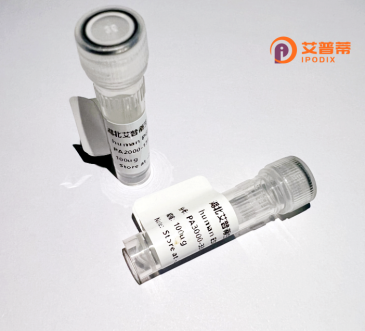
| 纯度 | >90%SDS-PAGE. |
| 种属 | Human |
| 靶点 | AP4E1 |
| Uniprot No | Q9UPM8 |
| 内毒素 | < 0.01EU/μg |
| 表达宿主 | E.coli |
| 表达区间 | 1-1137aa |
| 氨基酸序列 | MSDIVEKTLTALPGLFLQNQPGGGPAAAKASFSSRLGSLVRGITALTSKHEEEKLIQQELSSLKATVSAPTTTLKMMKECMVRLIYCEMLGYDASFGYIHAIKLAQQGNLLEKRVGYLAVSLFLHESHELLLLLVNTVVKDLQSTNLVEVCMALTVVSQIFPCEMIPAVLPLIEDKLQHSKEIVRRKAVLALYKFHLIAPNQVQHIHIKFRKALCDRDVGVMAASLHIYLRMIKENSSGYKDLTGSFVTILKQVVGGKLPVEFNYHSVPAPWLQIQLLRILGLLGKDDQRTSELMYDVLDESLRRAELNHNVTYAILFECVHTVYSIYPKSELLEKAAKCIGKFVLSPKINLKYLGLKALTYVIQQDPTLALQHQMTIIECLDHPDPIIKRETLELLYRITNAQNITVIVQKMLEYLHQSKEEYVIVNLVGKIAELAEKYAPDNAWFIQTMNAVFSVGGDVMHPDIPNNFLRLLAEGFDDETEDQQLRLYAVQSYLTLLDMENVFYPQRFLQVMSWVLGEYSYLLDKETPEEVIAKLYKLLMNDSVSSETKAWLIAAVTKLTSQAHSSNTVERLIHEFTISLDTCMRQHAFELKHLHENVELMKSLLPVDRSCEDLVVDASLSFLDGFVAEGLSQGAAPYKPPHQRQEEKLSQEKVLNFEPYGLSFSSSGFTGRQSPAGISLGSDVSGNSAETGLKETNSLKLEGIKKLWGKEGYLPKKESKTGDESGALPVPQESIMENVDQAITKKDQSQVLTQSKEEKEKQLLASSLFVGLGSESTINLLGKADTVSHKFRRKSKVKEAKSGETTSTHNMTCSSFSSLSNVAYEDDYYSNTLHDTGDKELKKFSLTSELLDSESLTELPLVEKFSYCSLSTPSLFANNNMEIFHPPQSTAASVAKESSLASSFLEETTEYIHSNAMEVCNNETISVSSYKIWKDDCLLMVWSVTNKSGLELKSADLEIFPAENFKVTEQPGCCLPVMEAESTKSFQYSVQIEKPFTEGNLTGFISYHMMDTHSAQLEFSVNLSLLDFIRPLKISSDDFGKLWLSFANDVKQNVKMSESQAALPSALKTLQQKLRLHIIEIIGNEGLLACQLLPSIPCLLHCRVHADVLALWFRSSCSTLPDYLLYQCQKVMEGS |
| 分子量 | 127 kDa |
| 蛋白标签 | His tag N-Terminus |
| 缓冲液 | 冻干粉 |
| 稳定性 & 储存条件 | Lyophilized protein should be stored at ≤ -20°C, stable for one year after receipt. Reconstituted protein solution can be stored at 2-8°C for 2-7 days. Aliquots of reconstituted samples are stable at ≤ -20°C for 3 months. |
| 复溶 | Always centrifuge tubes before opening.Do not mix by vortex or pipetting. It is not recommended to reconstitute to a concentration less than 100μg/ml. Dissolve the lyophilized protein in distilled water. Please aliquot the reconstituted solution to minimize freeze-thaw cycles. |
以下是关于AP4E1的3条参考文献,包含文献名称、作者及摘要概括:
1. **文献名称**:*Adaptor Protein Complex 4 Deficiency: A Paradigm of Childhood-Onset Hereditary Spastic Paraplegia*
**作者**:Moreno-De-Luca, A. et al.
**摘要**:该临床研究首次将AP4E1基因突变与儿童期遗传性痉挛性截瘫(HSP)及智力障碍相关联,发现患者表现出神经元内囊泡运输缺陷,提示AP-4复合体在神经轴突运输中的关键作用。
2. **文献名称**:*The AP-4 complex mediates lysosomal trafficking of ATG9A to regulate autophagosome formation*
**作者**:Hirst, J. et al.
**摘要**:研究通过细胞模型揭示AP-4复合体(含AP4E1亚基)参与自噬体形成的关键机制,证明其通过调控ATG9A的溶酶体运输维持自噬功能,突变可导致自噬障碍及神经退行性表型。
3. **文献名称**:*AP4E1 mutation causes impaired synaptic protein trafficking and developmental delay*
**作者**:Jia, D. et al.
**摘要**:利用CRISPR小鼠模型,该研究发现AP4E1缺失引发突触蛋白运输异常及神经元发育迟缓,从动物层面证实其突变通过扰乱囊泡运输导致认知与运动功能障碍。
---
这些研究从分子机制、临床表型及动物模型多角度解析AP4E1功能,突出其在神经细胞运输及疾病中的重要性。
AP4E1. a subunit of the adaptor protein complex AP-4. plays a critical role in intracellular vesicular trafficking and cargo sorting. As part of the heterotetrameric AP-4 complex (composed of ε, β4. μ4. and σ4 subunits), AP4E1 contributes to the formation of transport vesicles at the trans-Golgi network (TGN), facilitating selective packaging of transmembrane proteins into these vesicles for delivery to specific organelles, including endosomes and lysosomes. This complex is particularly crucial for maintaining neuronal function, as it mediates the sorting of autophagy-related proteins and receptors involved in lysosomal degradation pathways.
Mutations in the AP4E1 gene are linked to autosomal recessive hereditary spastic paraplegia (HSP) and intellectual disability syndromes. These disorders, collectively termed AP-4 deficiency syndrome, are characterized by impaired motor function, developmental delays, and neuropathological features such as altered axonal trafficking and defective autophagy. Studies using cellular and animal models have shown that AP4E1 loss disrupts cargo recognition and vesicle formation, leading to intracellular protein aggregation and neurodegeneration.
Research on AP4E1 provides insights into the molecular mechanisms of vesicle trafficking and its implications in neurological disorders. Targeting AP-4-mediated pathways could offer therapeutic strategies for conditions associated with trafficking defects, though current understanding remains incomplete, necessitating further exploration of its interactors and regulatory mechanisms.
×